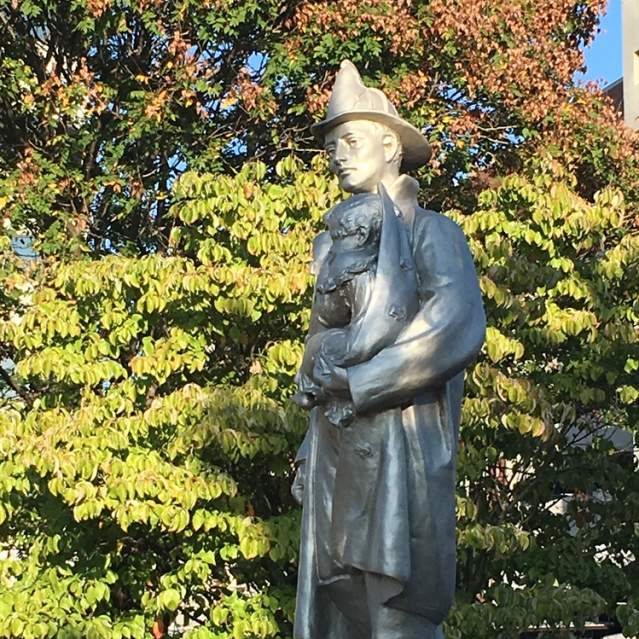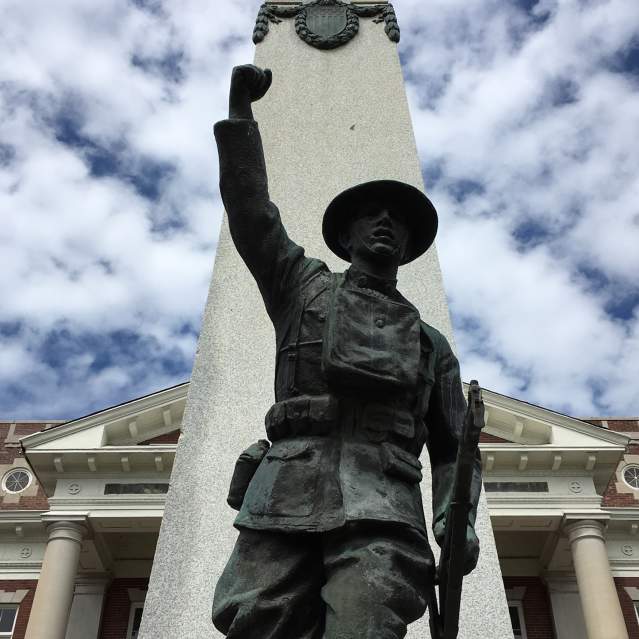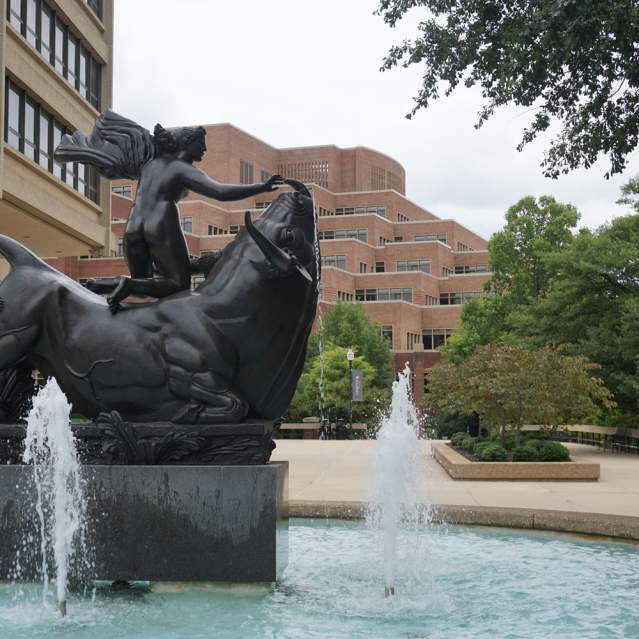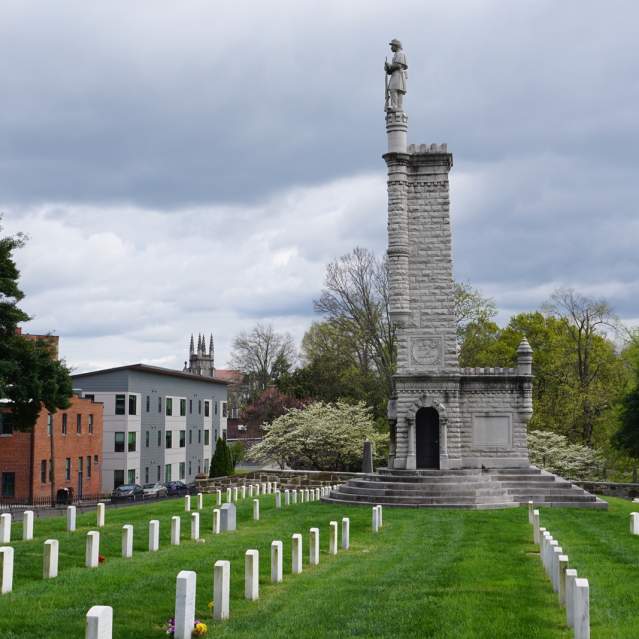There was a time when Knoxville seemed statue-shy—half a century ago, Knoxvillians could count their notable public statues on the fingers of one hand—but today there are striking statues all over. A New York Times columnist recently noted that Knoxville may be America’s only city with two statues celebrating women’s suffrage (both of them downtown, along Market Street on either side of Krutch Park, celebrate five individuals who were relevant to Tennessee’s passage of the Suffrage amendment in 1920). Meanwhile, in the last 20 years or so, UT has erected six different bronze statues of athletic coaches or players. All of those have gotten lots of attention and are worth seeing. Plus, several fine statues in private cemeteries, and a few others commissioned by public or private developers.
However, the city does have a few statues that are now a few decades old, and each of them seems to have a story that’s different, surprising, and perhaps even unique.
The Fireman
At the modern fire station on Summit Hill Drive, near Henley Street, is a striking statue of a fireman holding a baby. It’s an old-fashioned, sentimental statue suggesting the fire department’s role in saving the most innocent lives. Its sculptor is unknown. Although the theme of a fireman saving a baby has been interpreted by dozens of sculptors, this one is older than most, and not necessarily duplicated elsewhere. The statue is about 120 years old, one of Knoxville’s oldest monuments. It’s also one of the most restless statues in town. This is its fourth known location, and it may soon have a fifth.
Originally intended to memorialize two firemen who died in a wall collapse fighting a blaze on Gay Street in 1904, it was originally installed in 1905, and stood in the front lawn of the Knox County Courthouse. As Knoxville had been divided over the Civil War—and about most political figures—the Fireman may have been the city’s first universally respected subject to memorialize in a public place downtown. Apparently uncomfortable there, he soon migrated to the opposite end of Gay Street, at what was then known as Emory Park (now Emory Place where today, visitors can find Crafty Bastard Brewery, Lillienthal Gallery and Pivot Point Gallery, French Fried Vintage, and more) near the northernmost end of Gay Street. At the time, the park was Knoxville’s only urban park, and seemed to call for a statue, and the small fire station here on Emory Park made it seem relevant. But in 1944, a truck accidentally knocked it over, causing damage to its base, and considering that the firehall had closed, the city chose to move it again, this time to the expansive lawn of City Hall, at Henley and Western, where it was central to a garden site celebrated in the first Dogwood Arts Festivals of the early 1960s. But in the late 1970s, City Hall moved to the City County Building (near the statue’s original location), prompting a redesign of what was now known as Summit Hill Drive, which resulted in a modern new firehall, across the street from old City Hall—which became the fireman’s new location.
It's likely to move again, as the Fire Department Headquarters moves; a good fireman doesn’t stay put for long.
The Doughboy Statue
The lively bronze in front of what was originally Knoxville High School—the large, grand 1910 building at 101 East Fifth Avenue (just around the corner to the aforementioned Emory Place area) is now an apartment building—this 1921 statue was dedicated by the leader of U.S. infantry in World War I—Gen. John “Black Jack” Pershing himself—during a visit in 1922. It was a memorial to Knoxville men of the 117th Infantry who had died in what was then known as the Great War in 1917-1918, especially the dozens who had been students at this high school.
The identity of the sculptor has been a matter of lively debate. The sculpture is very similar to Indiana sculptor E.M. Viquesney’s “Spirit of the American Doughboy,” which was mass produced for at least 153 sites around the nation (140 are known today), but it’s not exactly like all the others, at least some of which depict a soldier at more of a walking pace, and raising a grenade, not merely a defiant fist, as ours does. It’s also been attributed to Ohioan John Paulding, whose “Over the Top to Victory” also depicts a soldier holding a grenade aloft. The 1921 installation date would have been very early for either model.
For many years, each Memorial Day (or Decoration Day, as the May holiday was called when the statue was new) the statue was a site of speeches and poetry readings, often by mothers of young men killed in action. The group would often proceed from here down Tyson Street to the National Cemetery, where there would be further ceremonies, often with a band concert.
It was the subject of some irreverent ribbing by high-school student James Agee (1909-1955), who attended this school in the mid-1920s. In one of the future Pulitzer Prize winner’s first published stories, “Knoxton High,” the teenager made fun of the statue’s presumably mass-produced origins, claiming that it was produced by the “Doughboy Statue Manufacturing Co.” Although it’s not identical to the others, there are a few dozen similar statues in cities and towns throughout the United States.
Spanish-American War statue
The statue of a soldier in a broad-brimmed hat overlooking Main Street near Gay is sometimes mistaken to depict a pioneer or a Civil War soldier. Sometimes known as “The Hiker,” it’s meant to honor the U.S. soldiers of the Spanish-American War. It was not actually erected until 42 years after that short war. It stands on a rock that had been hauled down from the then-new Great Smoky Mountains National Park. Sponsoring it were hundreds of veterans of the war still living in East Tennessee, most of them in their 60s or 70s; many of them were here to attend the statue’s unveiling in June 1940.
In its early days, the statue sometimes played a role in a Memorial Day procession from the Gay Street Bridge to the National Cemetery, as a site for memorial speeches.
Cast in Providence, R.I., it’s one of several dozen statues of similar design across America, but the tree-shaded setting makes this one different. At times, drooping tree branches have crowded the statue’s head, as described in David Madden’s 1974 novel, Bijou, set in 1946, in which a boy finds he can hide from the world by climbing the statue and sitting on its hat, concealed by leaves; the author claims that he once did that, himself.
By the way, in the inscriptions at the base of the statue, you may notice the phrase “Porto Rico.” That’s not a misspelling, at least not exactly. For whatever reason, during the early period of colonial occupation that began with the end of the war, U.S. authorities chose to spell it that way; it was during a time when many American editors preoccupied themselves with reducing the length of words (including English words like dialogue) by spelling them phonetically. It reverted to the proper Spanish Puerto Rico by an act of Congress in 1932. By then, the plan for this plaque was apparently set in stone, so to speak.
Europa and the Bull
Of course, right across Volunteer Boulevard from the Volunteer, at the foot of McClung Tower, is an equally eye-catching statue, Europa and the Bull. Unveiled in May 1968, just the month after the Volunteer, it has a very different history. It’s the third and last casting of one of the most notable works of Swedish sculptor Carl Milles (1875-1955), who created the original in 1924. Two others stand in Halmsted, Sweden, and Cranbrook Academy in Michigan. Heiress Ellen McClung Berry, who reportedly had some acquaintance with Milles, endowed the erection of this statue, with the understanding that it be the last. Although the other two versions are well kept, in public spaces, photographs of the UT statue have been used to represent the best of Milles’ work in international sources like Encyclopedia Britannica. The plaza around the statue witnessed dozens of dramatic scenes, from antiwar protests of the late ‘60s to some of the most outrageous moments of the streaking fad of 1974.
The Alex Haley Statue
Located in Haley Heritage Square, a part of Morningside Park designed for it, the seated Haley statue, holding a book as if telling a story, honors the storytelling legacy of author Alex Haley (1921-1992), journalist and author of important books like The Autobiography of Malcolm X and, more famously the international bestseller, Roots, which combined with its extremely popular television series, had a major impact on America’s impressions of the legacy of slavery. Born in a small town in West Tennessee, Haley was not originally from Knoxville, but began making close friends here at the time of the 1982 World’s Fair, and by 1986, he was living here, a familiar speaker at UT campus, which now holds his papers. Generous with his time for community projects, he was universally beloved in his adopted city.
The statue began as a dream of Nkechi Ajanaku (ca. 1957-2017), a community leader who had known Haley. Working with generous donors and help from the city, erected what was at the time the largest statue of an African American in the world. (The newer stone statue of Martin Luther King in Washington, D.C., is bigger). To do the job, the planning committee hired California artist Tina Allen (1949-2008), who made a career of celebrating African American achievement in bronze. This may be her largest statue. Completed and installed in 1998, the 13-foot-tall seated sculpture was intended to invite children to climb on it, as if to sit in Haley’s lap as he reads—though considering that bronze can be slippery, and the surface beneath it is solid stone, few moms would recommend that option. It has been the site of dozens of commemorative events, including pocket festivals and readings from well-known African American writers, members of Haley’s family, and a public memorial for Ajanaku after her death in 2017.
The Union Monument
Located in the old Civil War-era National Cemetery on Tyson Street, a couple of blocks off of Broadway on the northwest corner of downtown, the tall marble Union monument has a story that’s a little bizarre. It’s reputedly the tallest Union monument in the South, and there’s a reason for that. Even though post-Civil War Knoxville was politically and financially dominated by Republicans—that is, former Unionists—a Confederate minority had gotten together to erect a tall monument over a mass grave of soldiers in a private cemetery in East Knoxville. The graying Union veterans realized they’d need to match that bet and raise it, by building a slightly taller monument in the National Cemetery, by that time already populated with more than 3,000 graves of Union soldiers. After a massive fundraising appeal, and many delays, a cornerstone was laid in 1896. An early idea was to put a statue of a Union infantryman on top of a castle-like tower. But its unveiling at a big ceremony attended by hundreds of Union veterans had a surprise: surmounting that stone tower was a rampant bronze eagle, wings spread, atop a large cannonball. All that was secured into the base with iron bars. For three years, that sculpture was much admired. However, during a spring storm on a late afternoon in 1904, a thunderbolt struck with a force like an earthquake. Downtown buildings emptied as Knoxvillians looked to see what happened. What they found was that a bolt of lightning had struck the monument, tearing apart the stone base and breaking the bronze eagle into several pieces.
Designers realized they shouldn’t have used so much iron in the construction. They raised money again, this time with major help from Republican Congressman Henry Gibson, himself a veteran of the Union supply trains, who obtained a federal grant for the project. This time, they skipped the bronze eagle and returned to the original design, building a monument, equally large, but entirely of stone. Completed in 1906, it has never been struck by lightning.
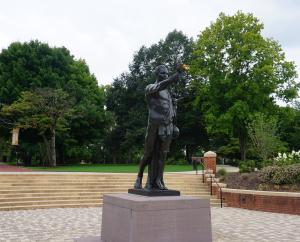 The Volunteer
The Volunteer
Perhaps the statue with the longest period of gestation is on UT’s campus: The Volunteer, also informally known as the “Torchbearer,” is the classical statue prominently visible at the bend of Volunteer Boulevard at the entrance to Circle Park. Statuary depicting the spirit of a rapidly growing university was first proposed in the late 1920s, during the administration of Harcourt Morgan, culminating in a national contest of sculptors to interpret the theme. Picking the winner was a jury led by nationally known Chicago sculptor Lorado Taft, who arrived on the train for a series of receptions. Assisting him as jurors were Knoxville architect Charles Barber, then becoming known as the chief designer of UT’s collegiate buildings, and artist and art teacher Robert Lindsay Mason.
The winner they picked was a model by a Yale University student named Theodore Beck.
A UT committee insisted on some tweaks to the design—Beck’s original held a lantern, not a torch, and appeared to be getting on in years. UT’s leadership thought the symbol should be a young athletic fellow in top shape—perhaps a candidate for Major Neyland’s Vols—and that he should carry a torch, which seemed bolder than a lantern. The first proposal was that it should be as much as 20 feet tall, and to stand near the entrance to campus, perhaps in the middle of Cumberland Avenue at the foot of College Hill.
However, despite all the hubbub, the Depression, followed by a change in UT’s administration in 1933, when Morgan became one of the original directors of the Tennessee Valley Authority, kicked the expensive project down the road. Although the university was using the term “Torchbearer” to describe leading students by 1937, the proposed statue project itself was slowly forgotten.
By the mid-1960s, when UT’s campus was undergoing its biggest expansion in history, former President Morgan, his successor James Hoskins, as well as jurors Taft, Mason, and Barber, in fact almost all of the original planners, had died. But the graduating Class of 1967, made up of students born long after the statue was designed, learned about the effort, and chose to revive it as a gift to their alma mater: impressively tall, if not as tall as once proposed. It was installed in April 1968, with a torch eternally lit with gas. It’s unknown whether the original sculptor, Mr. Beck, ever heard about it.
Sergei Rachmaninoff
Of all Knoxville statues, perhaps the most surprising story of all is surely that of Mr. Sergei Rachmaninoff. The Russian composer gave his final piano performance at UT’s Alumni Auditorium in early 1943, and then suffering from cancer, canceled the rest of his American tour. Less than six weeks later, he died. About 50 years later, an obscure Russian sculptor named Viktor Bokarev, a lifelong admirer of Rachmaninoff, sculpted a memorial statue of his idol, with the wish that it be mounted in the city where he gave his final concert. At first, he could find no takers. The white plaster sculpture was not yet bronzed, which would be a significant expense, and many in Knoxville were unaware of the city’s association with one of the 20th century’s greatest composers. The city, the university, and local arts groups declined the gift. However, in 1996, a resident of an unusual space on Gay Street agreed to take custody of Rachmaninoff. For several years, the melancholy 10-foot-tall statue stood in an interior stairwell at 124 S. Gay Street. Many assumed it might stay there indefinitely. At least two successive households learned to live with it. Finally, in 2003, a consortium of lovers of the arts raised the funds required to have the statue bronzed and erected in a quiet, tree-shaded southwestern corner of World’s Fair Park—facing in the general direction of Alumni Auditorium, on the far side of the Hill, where he gave his final concert, playing his own work—as well as Chopin’s famous “Funeral March”— to an appreciative crowd. It’s believed to be the only statue of Rachmaninoff in the Western Hemisphere.


